| |
# |
Site |
Comments |
Photo |
Visits |
41 |
Winchester / Kernstown
Shenandoah
Battlefields National History District, Winchester
Virginia |
The site of five Civil War battles, the city of Winchester at the northern (lower) end of the Shenandoah Valley, changed hands over 70 times during the Civil War. Three battles are named Winchester: 1st [25 May 1862 in Jackson's Valley campaign], 2nd [13-15 June 1863, Ewell clears Valley of Yankees prior to Gettysburg] & 3rd [Sheridan pushes Early south]. Two more battles were at adjacent Kernstown: 1st [23 Mar 1862, Jackson defeated in his first Valley fight] & 2nd [July 24 1864, Early beats Crook during raid to D.C.]. In addition, "Stonewall" Jackson and wife lived here early in the War.
A non-profit NGO is actively attempting to save battlefield parcels, although none were open during our short visit in June 2009. There is a Winchester-Frederick County Civil War Orientation Center with good museum that is worth visiting, and they provide a great brochure. T.J. Jackson's home is operated as a museum with docents in period costume. Our visit was fun and we anticipate seeing actual parts of battlefields in the future. |
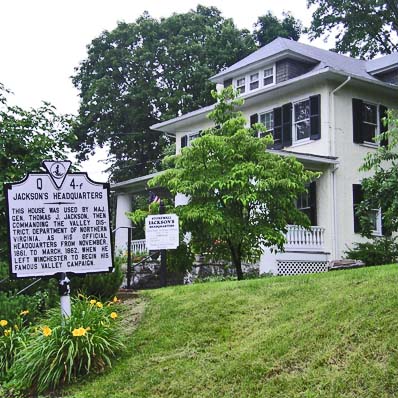
"Stonewall" Jackson house in Winchester,
site of his headquarters Nov 1861-Mar 1862
(June 2009) |
June 2009 |
42 |
Guinea Station
Stonewall Jackson Shrine, Fredericksburg & Spotsylvania National Military Park
Virginia

|
The office building on Thomas C. Chandler's 740-acre plantation "Fairfield" is the "house where Stonewall Jackson died," and is today termed the "Stonewall Jackson shrine." It is exceptionally well-maintained and interpreted, and one can see his room and bed where he died of wounds suffered at the Battle of Chancellorsville. During that 2 May 1863 battle, he was mistakenly shot at dusk by his own troops. The ambulance brought him here, near a rail station, and his wife Mary Anna and baby daughter arrived 7 May. Jackson died on 10 May 1863.
This small building is the only remaining structure at the Chandler plantation. The mansion and other buildings burned sometime after the Civil War. This building has been a Jackson "shrine" since the early 1900s. It was renovated in the 1920s and the 1960s, but still retains about 45% original material. The docents during my visits tended to consider Jackson a saint, but one can smile and just enjoy the site.
|
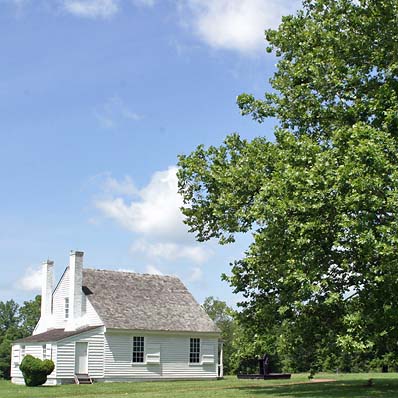
House where T.J. "Stonewall" Jackson died, on the "Fairfield"
plantation, Guinea Station (June 2009) |
June 1967,
June 2009 |
43 |
Ox Hill
(Chantilly)
Ox Hill
Battlefield, Fairfax County Park
Virginia

|
The
fight at Ox Hill (or Chantilly to the North) is almost entirely
overlooked in Civil War history. Yet here, in a pouring rainstorm on
Sep. 1, 1862, Union Generals Isaac Stevens and Philip Kearny attacked
'Stonewall' Jackson's flank march, intended to cut off the Union
retreat from the Second Battle of Manassas, and thwarted that aim. It
was an incredible fight over 500 acres of farmland, leaving 800
Confederate and 1300 Union casualties. Both Gen. Stevens and Gen.
Kearney were killed.
A hundred years later,
Fairfax County was rapidly being developed. In 1987, a non-profit group
managed to save five acres at the heart of the battlefield -- just 1%
of the original battle site. It opened as a county park in Aug 2008.
Yet, a remarkable site has been created with great maps and signage on
the walking tour route and a reconstructed snake rail fence. I rate it
very highly for working with what is available. |
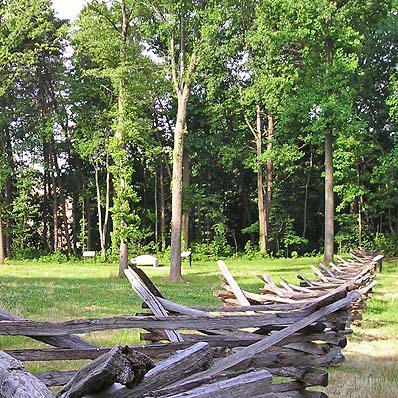
Os Hill battle site, with monuments marking the deaths of Gen. Kearney
and Gen. Stevens at the far end of the field (June 2009) |
June 2009 |
44 |
Balls Bluff
Ball's Bluff Battlefield Regional Park
Virginia

|
The public outcry after the skirmish at Balls Bluff on 21 Oct 1861 far exceeded its importance. Col. Edward D. Baker, former Senator and personal friend of Lincoln (who named his second son after Baker), led a "slight demonstration" against "Shanks" Evans rebel forces here. The brave but tactically inept assault got his command ambushed; Baker and 48 Union soldiers were killed. Baker's death shocked official Washington and led to the formation of the Congressional Joint Committee on the Conduct of the War.
Balls Bluff battlefield is now a very lovely regional park. Trails through the woods to the Potomac bluffs are complemented by excellent modern signs explaining the battle and its participants, including the "California Regiment" (actually the 71st Pa. regiment named to honor Baker, a leading San Francisco lawyer before the War). As I am from California, and physically far removed from Civil War sites, this sign was a nice touch. |
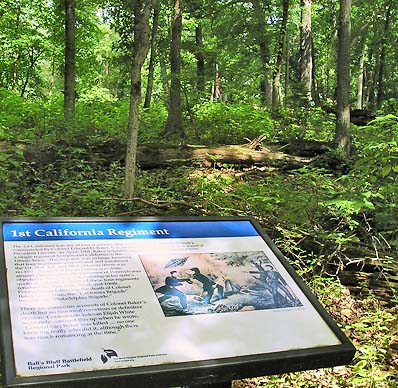 A sign in the woods at Balls Bluff commemorates the "California Regiment" led by former Oregon Senator, and Lincoln's friend, Edward D. Baker (June 2009)
A sign in the woods at Balls Bluff commemorates the "California Regiment" led by former Oregon Senator, and Lincoln's friend, Edward D. Baker (June 2009) |
June
2009 |
45 |
Olustee
Olustee State
Battlefield
Florida

|
Far away from the focus of public attention on Richmond or Atlanta in 1864, Northern forces consolidated gains elsewhere in the Confederacy. Efforts to do so in the Florida panhandle, though, suffered a sharp setback at Olustee, Florida, on 20 Feb 1864. The battle was fought in pine woods and palmetto thickets, with CSA troops under Joseph Finnegan scattering Union forces under Gens. Seymour & Gillmore. The 54th Mass. Infantry, though, of Battery Wagner fame (see below), held the field in a rear guard action, permitting an orderly Union withdrawal. Casualties were ~1850 USA and ~950 CSA (of ~5000 troops on each site, so these are heavy casualties).
The battlefield site is very nicely preserved as a State Park, and well interpreted with modern signs. Of note to birders (like me), the piney woods has Red-cockaded Woodpeckers, a federally-listed Endangered species. |
 Pine woods with palmetto understory are features
Pine woods with palmetto understory are features
of the battlefield at Olustee (Dec 2002) |
Dec 2002 |
46 |
McDowell
McDowell Battlefield, Highland Museum & Heritage Center
Virginia

|
McDowell was the first battle of "Stonewall" Jackson's 1862 Shenandoah Campaign, designed to draw Federal troops away from McClellan's effort to take Richmond. Jackson marched his brigades 92 miles in 4 days into the Appalachians to confront part of Fremont's army. Gen. Milroy's brigade was at McDowell. When the federals learned of Jackson's approach, Gen. Schenck marched his brigade 34 miles in 23 hours to Milroy's support. Despite being outnumbered, Schenck attacked the rebels on the heights above McDowell, and the battle raged into the night. Northern heroics contributed to rebel casualties (~500) that were double those of the attackers, until Schenck was withdrawn by Fremont. Jackson returned to the Shenandoah. Jackson could claim his strategic purpose -- Fremont was stalled (but Fremont wasn't planning to go anywhere) -- yet the battle was a tactical Union victory. This point is usually overlooked in Civil War literature.
Although there is not much battlefield to visit, a remarkable little museum is here, and the site is stunningly exotic in these rough mountains.
|
 Painting of "Stonewall" Jackson & staff on heights overlooking McDowell (top)
Painting of "Stonewall" Jackson & staff on heights overlooking McDowell (top)
and church at center of McDowell town (bottom; June 2009) |
June 2009 |
47 |
Fort Monroe
Fort Monroe National Monument
Virginia
|
At the entrance to Hampton Roads, Virginia, and once the most impressive fortress on the Atlantic coast of North America, a long litany of history occurred here. The Fort was held by the Union throughout the Civil War. Several major campaigns were launched from here. Commanding Gen. Benjamin Butler announced his "Fort Monroe Doctrine" on 27 May 1861. Escaping slaves who reached Union lines would be considered contraband and not be returned to bondage. Thousands of slaves fled to Union lines. At War’s end, Jefferson Davis was confined in an unheated cell that is now part of its Casemate Museum. All these topics are covered in the Museum, in the catacombs beneath the walls. You can see Davis's prison cell; the quarters occupied by R.E. Lee (he had a major role in the final construction 1831-1834); and where Pres. Lincoln was a guest in May 1862. I ran out of time before I could visit everything, but the exhibits were much more impressive than anticipated
Fort Monroe was decommissioned in 2011; Pres. Obama then designated portions as a National Monument. Although not a battlefield per se, it is a “must see” Civil War site, as are the Confederate White House, Ford’s Theatre, and Andersonville.
|
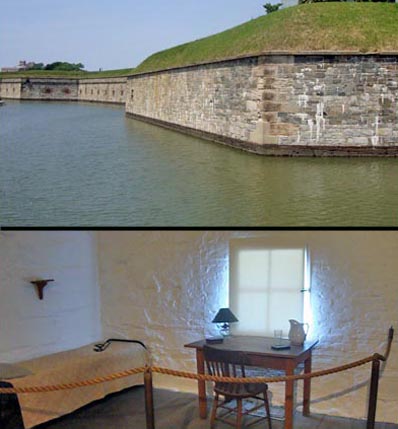 Walls and moat at Fortress Monroe (above); room in which Jefferson Davis was imprisoned post-war (below; June 2013) Walls and moat at Fortress Monroe (above); room in which Jefferson Davis was imprisoned post-war (below; June 2013) |
June
2013 |
48 |
Grand Gulf
Grand Gulf State Park
Mississippi

|
During U.S. Grant's Vicksburg Campaign, Adm. Porter led seven ironclads in an attack on the Confederate batteries at Grand Gulf on 29 Apr 1863. Although the rebels withstood the Union bombardment, Union steamboats and barges ran the gauntlet after dark, permitting Grant to move his army across the river, disembarking them on the Mississippi shore below Grand Gulf. The set-back here was just a minor delay.
In March 1997 Rita & I had the extraordinary good luck to run into a tour here led by legendary historian Edwin C. Bearss. He graciously permitted us to tag along. It is said that a "battlefield tour with Ed Bearss is a transcendental experience," and having spent a couple hours listening to him bring history alive, we certainly agree! Those who have watched Ken Burns' Civil War series know his dramatic narratives. The battlefield is a State Park with a nice museum and ruined fortifications. It was partly flooded during our visit, but we — and Ed Bearss's tour bus — plunged right through the flooded road to get there. |
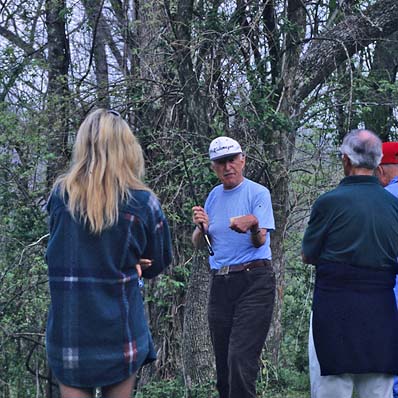 Edwin C. Bearss narrates the Battle of Grand Gulf on the
Edwin C. Bearss narrates the Battle of Grand Gulf on the
battlefield there (March 1997) |
Mar 1997 |
49 |
Carnifex Ferry
Carnifex Ferry Battlefield
State Park
West Virginia

|
Carnifex Ferry is a little-known battle early in the War, in what was then Virginia. The Union victory here resulted in retaining these western counties in Union control, allowing the process of West Virginia statehood to proceed.
On September 10, 1861, about 5000 Union troops, led by Brig. Gen William S. Rosecrans, attacked Confederates forces, under the command of Brig. Gen. John B. Floyd, that were entrenched on the Henry Patterson Farm. The attack forced Floyd and his 2000 men to retreat. Later than night, using the Carnifex Ferry, Floyd's foces crossed to the south side of the Gauley River. The Confederate effort to regain control of the Kanawha Valley failed. This was an early clash between Generals who would feature in later, and larger, battles in the Tennessee theatre.
The small battlefield is well-interpreted in the Park's museum, located in the restored Patterson farmhouse. The site has spectacular views of Gauley River canyon, which is now protected within the adjacent Gauley River Nat'l Recreation Area, noted for its white-water rapids and fishing. On a sunny day in June, it was a lovely spot to picnic on tables overlooking the Gauley River. |
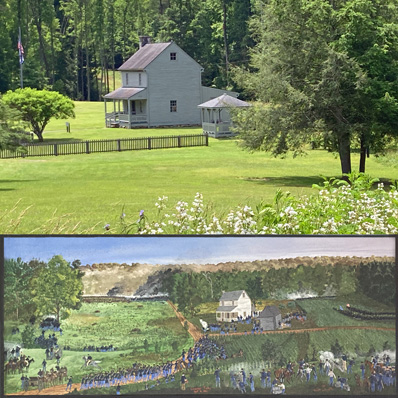
Carnifex Ferry battlefield with Patterson Farm, now the battlefield museum,
and inset of an artist's view of the battle in the museum, showing the
Union attack downslope toward the Patterson house
(June 2002) |
June
2022 |
50 |
Sabine Pass
Sabine Pass Battlefield State Historic Site
Texas

|
On 8 Sep 1863, a Union flotilla of 4 gunboats and 18 troop transports carrying 5000 troops, under the command of Captain Frederick, steamed into Sabine Pass with the intention of reducing Ft. Griffin and begin the occupation of Texas. The Confederate gunners, commanded by Lt. Dick Dowling, had been practicing firing artillery at range markers on the oyster shoals in the river. This practice paid off. The Fort’s force of 44 men sank two gunboats and captured 200 prisoners. The Yankee fleet sailed back to New Orleans. The heroics at Fort Griffin—44 men stopping a Union expedition—inspired other southerners.
The historic site now sits at the edge of Sabine Pass. In the 150 years since the War, the river has changed course and the original Ft. Griffin is gone. More recent battlements, some of WWII vintage, dot the location. Yet a cleverly designed all-weather walk-in kiosk describes the battle well. There is a path with explanatory signage – including a “1863 view” of the battle through an all-weather viewer – and a statue to the Confederate gunners. Having rather little to work with, the battlefield park is very nicely done. |
|
Apr
2014
|
|
RECOMMENDED BOOKS & MEDIA :
41. Battles at Winchester / Kernstown [First Winchester, Second Winchester, Third Winchester; First Kernstown, Second Kernstown]
- Books: I don't have a definitive history of Jackson's 1862 Shenandoah Campaign; some that I looked at had a whiff of hagiography. The essays in editor Gary W. Gallagher's (2003) The Shenandoah Valley Campaign of 1862 are good, and from a broad perspective deal with First Kernstown and Winchester. In a way, Robert K. Krick's (1996) Conquering the Valley: Jackson at Port Republic does so as well, but its real (and very detailed) focus is on Port Republic and Cross Keys. Jeffrey D. Wert's (1997) From Winchester to Cedar Creek: The Shenandoah Campaign of 1864 covers Third Winchester decently.
42. Guinea Station: the Stonewall Jackson shrine
- Media: The 2003 movie Gods & Generals, starring Stephen Lang (as Jackson)) and Robert Duvall (as Lee), includes Jackson's death at Guinea Station. That part of the movie is excellent. See a longer review above, under Chancellorsville, above.
- Books: Jackson is an interesting and eccentric character (maybe even a nut-case), but he has been so long deified by the South that it is difficult to find literature that is unbiased. [I sold my 2 vol. set of Col. Henderson's (1899) Stonewall Jackson and the American Civil War, as its apparent goal was to create a sainthood for Jackson.] James Robertson's (1997) Stonewall Jackson: the Man, the Solider, the Legend is considered the standard current biography, and it is surely the best researched (900+ pages, including footnotes). Alas, there is a whiff of hagiography, not withstanding the attempt to avoid it. Personally, I found Byron Farwell's (1992) Stonewall: a Biography of General Thomas J. Jackson to be more even-handed in attitude, but it is not foot-noted nor is it based on original research.
43. Battle of Ox Hill (Chantilly)
- There is a fabulous animated battle map on the Civil War Trust site; the site also has photos and much information on battlefield preservation [links added in earlier versions of this page don't seem to work anymore].
- Books: David A. Wilker's (2002) Tempest at Ox Hill: The Battle of Chantilly is an excellent history, but could use better maps and photos.
44. Battle of Balls Bluff
- Books: I don't yet have a book on this small battle, but James A. Morgan III's (2011) A Little Short of Boats: The Fights at Ball's Bluff and Edward's Ferry, October 21-22, 1861 looks intriguing. I have not yet seen it.
45. Battle of Olustee
- Books: I have not yet read any book on this battle, and know rather little beyond what I learned during my visit. I see that there are at least three choices on-line.
46. Battle of McDowell
- Books: I don't have a definitive history of Jackson's 1862 Shenandoah Campaign; those I have looked it had more than a whiff of hagiography. But the essays in editor Gary W. Gallagher's (2003) The Shenandoah Valley Campaign of 1862 are good, and one by William J. Miller entitled "Such Men as Shields, Banks, and Fremont," (pp. 43-85) has a decent one-page summary of this battle. Miller quite properly writes: "The fight at McDowell had national repercussions, at least for southerners, in providing a much-needed boost to flagging Confederate morale. Though Jackson's men had again been worsted tactically, despite immense advantages in terrain, they could claim a a strategic victory. To the Federals, however, McDowell meant little. ... In fact, Fremont treated the Virginian's foray into the mountains as merely an annoyance, after which he returned to his primary business: solving his supply problems and making a lodgment on the Southwest Virginia & Tennessee Railroad;" [emphasis added]. So much for the "first victory for Jackson" in his Valley campaign.
47. Fort Monroe
- Books: The primary book is John V. Quarstein & Dennis Mroczkowski's (2000) Fort Monroe: The Key to the South. The directors of the Virginia War Museum and Ft. Monroe's Casement Museum, respectively, put together this slim, but very heavily illustrated, paperback that covers the topics one is likely to want to know about the Fort. However, it does so in photo captions, not an actual narrative, which makes the effort a bit choppy. Obviously, William C. Davis' (1991) Jefferson Davis: the Man and his Hour: a Biography will have details on his post-war confinement here.
48. Battle of Grand Gulf
- Books: I have not read nor seen a book focused on this single battle. James Arnold's (1997) Grant Wins the War: Decision at Vicksburg, a fast-paced history of the entire Vicksburg campaign, includes details of this battle.
49. Battle of Carnifex Ferry
- Books: Mark Snell's West Virginia and the Civil War (2011) paperback book, in the Civil War Sesquicentennial Series, covers the small engagement on pages 48-49. There is more in the battlefield museum than in the book, but Snell does note that beyond Generals Rosecrans and Floyd, colonels Robert McCook, on the Union side, and colonel Henry Heth, on the Confederate side, both rose to generals and fought in multiple battles thereafter. In addition, two future U.S. presidents — Rutherford B. Hays and William McKinley — were among the Federal troops at Carnifex Ferry.
50. Battle of Sabine Pass
- Books: The definitive account is Clifton & Shirley Caldwell's (2004) Sabine Pass: The Confederacy's Thermopylae. It has a thorough review of the battle, its setting, and the aftermath. Long after the War, Jefferson Davis called Sabine Pass "the Confederacy Thermopylae." It was was thoroughly educational to be properly reminded of that ancient battle between Greek and Persian empires. In the 19th century, it was familiar to all. Now, for most of us, long forgotten.
|
or the choices via links at right:
|
|
|
|
|















